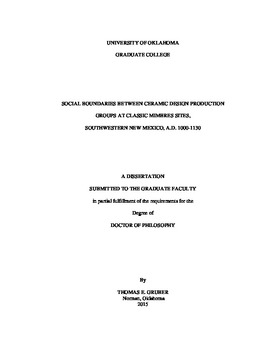| dc.contributor.advisor | Gilman, Dr. Patricia A. | |
| dc.contributor.author | Gruber, Thomas | |
| dc.date.accessioned | 2015-05-06T16:48:24Z | |
| dc.date.available | 2015-05-06T16:48:24Z | |
| dc.date.issued | 2015-05-05 | |
| dc.identifier.uri | https://hdl.handle.net/11244/14574 | |
| dc.description.abstract | The identification of social boundaries relies on the presumption that differences between production groups only reliably manifest in aspects of material culture that are not overt, because the more rote a choice made in the production of material culture the less likely it will be influenced by other social factors. The aim of this research is not to understand the size of production groups, but rather to understand the formation of social boundaries between production groups at sites in the Mimbres region during the Classic period as a means of understanding community formation. Defining design production groups in the Mimbres region can contribute to defining communities. The expectation of this microstylistic study is that it will show that some sites have less spatially definable social boundaries between design production groups than other sites showing the variability of community organization in the Mimbres region.
The choices a person makes during the creation of material culture are learned from the production group with which the individual works, and some differences in the choices people make are indicative of social boundaries between groups of people. This research will use not only production steps that are easily visible to a member of another production group but are not easily reproduced without close interaction in an attempt to understand social boundaries between production groups within Mimbres sites. The aim of this research is not to understand the size of production groups, but rather to understand the formation of social boundaries between production groups at sites in the Mimbres region during the Classic period as a means of understanding community formation.
To identify ceramic design production groups and compare variation in social organization of ceramic design production groups in the Mimbres region within a few generations, microstylistic designs are considered. In this study, I use the variation in the production of the stepped and zigzag motifs to identify design production groups or "Schools" using Beazley's terminology. The variation in the zigzag and stepped motifs includes the arrangement and placement of the motifs, the number of times the motif is repeated, and 18 formal elements, which include the differences in the general shapes of the two motifs. The arrangement of both motifs is categorized by the whole vessel's finite symmetry, the design structure. The placement of the motif is the zone the motif occurs, and how the motif is arranged in the zone. The combination of the arrangement and formal elements allows for a detailed description of each motif and how it is arranged on each bowl.
There is a recursive relationship between population growth, ritual, and pottery and room production. Galaz like other sites during the Late Pithouse period used kivas to attract people, The result was as suggested by Powell-Marti and James (2006) a population of people that sent bowls produced at Galaz to neighboring sites creating the need to produce more ceramics than needed. It is possible that the bowls being distributed to other sites were used as a means of attracting people to Galaz. In addition, the people moving the bowls may not have inhabited Galaz, but may be from other sites who took the bowls home after visiting Galaz for some ritual or communal activity helping to develop Galaz as a ritual center resulting in the creation of larger communal structures over time. As the cycle of people moving into Galaz and producing more ceramics continues, the result over time would be the increasing the number of people involved in ceramic production groups and rooms being constructed in room blocks by unrelated people from neighboring sites. The result of incorporating unrelated people and increased social interaction because of producing more ceramics than needed inhibited the development of social boundaries between ceramic production groups at Galaz. | en_US |
| dc.language | en_US | en_US |
| dc.subject | Archaeology, Mimbres, Ceramics, Production | en_US |
| dc.title | SOCIAL BOUNDARIES BETWEEN CERAMIC DESIGN PRODUCTION GROUPS AT CLASSIC MIMBRES SITES, A.D. 1000-1130 | en_US |
| dc.contributor.committeeMember | Minnis, Dr. Paul E. | |
| dc.contributor.committeeMember | Livingood, Dr. Patrick | |
| dc.contributor.committeeMember | Swan, Dr. Daniel | |
| dc.contributor.committeeMember | Cline, Dr. Rangar | |
| dc.date.manuscript | 2015-05 | |
| dc.thesis.degree | Ph.D. | en_US |
| ou.group | College of Arts and Sciences::Department of Anthropology | en_US |
